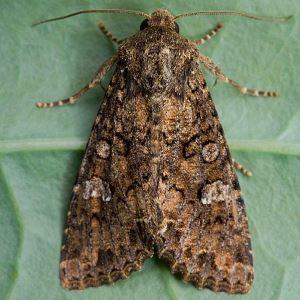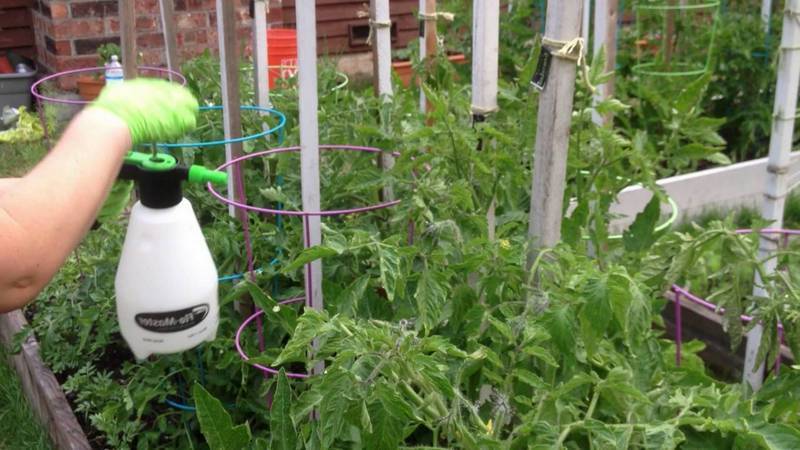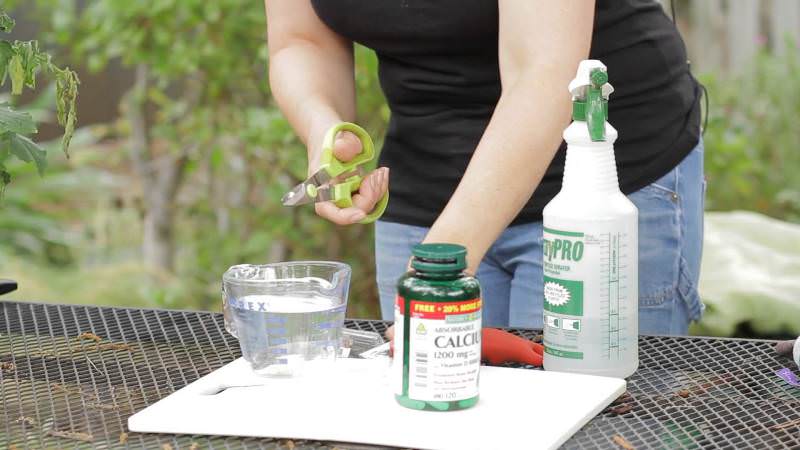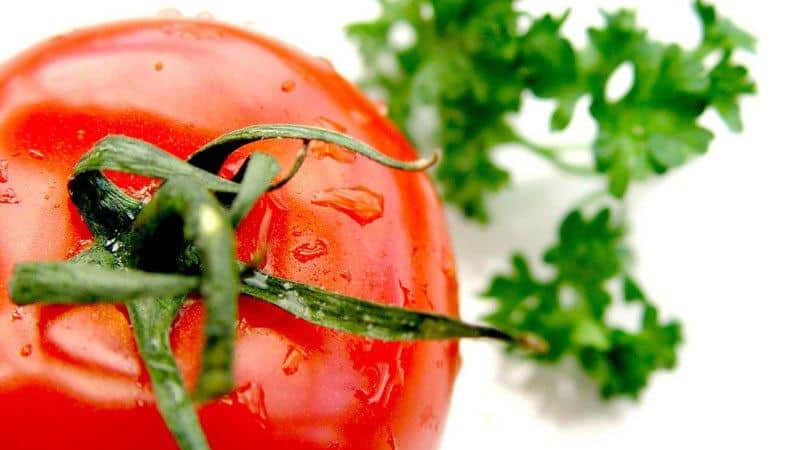What to do if there are caterpillars in tomatoes - popular methods of pest control
Painstaking work on growing seedlings tomatoes, picking young bushes and transplanting plants to a permanent place are reduced to zero pests, which novice gardeners do not even notice. These invisible “enemies” are ordinary caterpillars on tomatoes. From the article you will learn how to properly deal with such a scourge.
What caterpillars eat tomatoes?

In situations with damage to tomato crops, two representatives of butterflies “lead” - the cutworm and the whitefly. Moreover, both types of insects are capable of destroying plantings in 2–3 weeks if measures are not taken in time. Let's start with a description of these pests so that the gardener can easily recognize the “enemy by sight.”
The scoop is a dangerous enemy for novice summer residents. This unattractive butterfly looks like a moth. The size of the pest does not exceed 45 mm, and the wings are brown with a simple pattern of stripes and dots. The insect's fertility is high - the butterfly lays up to 500 larvae during its life.
Attention! Armyworm eggs are left mainly on leaves and peduncles, attaching future offspring with a flat edge to the surface of the plant.
Caterpillars develop from the clutch in 10–20 days, which eat the fruits, stems and leaves. Damaged tomatoes are unfit for consumption, and infected bushes die over time.
The cunning of the scoop is that she carries out her harmful activities at night. For this reason, inexperienced gardeners do not immediately notice warning signs, and understanding the reasons for tomato spoilage comes only after discovering holes in the fruit.
Whitefly – small midge with a yellow belly, whose dimensions reach 3 mm. This species of butterfly lives on tomato leaves, feeding on the juices of the plant. This is where the larvae lay, which subsequently begin to devour the fruits.
In addition to mechanical damage to fruits, whiteflies carry bacterial diseases. The consequence of such an invasion is the deformation of an already mature fruit and even the drying out of the bush.

Causes of pests
When understanding the causes of pests, gardeners talk about a combination of factors. The first signal for daily monitoring of plantings is warm, humid weather - these are the conditions that are favorable for the reproduction of insects.
The second reason why caterpillars have infested tomatoes is the proximity of pest-infected fruit trees and plantings of zucchini, paprika or eggplant to tomato bushes. Flowering weeds also become an additional source of food for these insects.
Important! Tomato pests are often nocturnal. In twilight and darkness it is difficult to detect a small but dangerous enemy.
Both types of insects more often damage plantings in open ground. Although the construction of a greenhouse does not guarantee 100% crop protection. The only alternative in such cases is a daily fight against uninvited guests.
Options for getting rid of the pest
When dealing with the question of how to get rid of caterpillars on tomatoes, gardeners try all sorts of tricks - advice from neighbors, buying special insecticides, planting plants that repel the pest and other effective methods.
Among the means available to summer residents, the following methods are used:
- Chemical treatment. In this case, you cannot do without purchasing pesticides to poison insects.
- Biological poisoning. Here, “gentle” agents are used to treat developing plants.
- Folk remedies. This option involves destroying caterpillars using time-tested methods.
The choice of a specific approach is determined by personal experience and the current situation. Let’s find out in more detail how effective the listed points are, and how to save the plantings with minimal damage.

Chemical attack
Let's start with an effective, but not the safest way - treating the garden with pesticides of hazard classes 1–3. Such actions guarantee the death of the insect population. However, it is recommended to treat plants with “heavy” chemicals at the flowering stage. This point is explained by the time frame for removing harmful substances from the soil and bush, which is up to 20–30 days.
The list of similar “working” drugs that have received favorable reviews includes “Inta-Vir” and “Avant”. Both products destroy pests at any stage of development. To poison insects, you need to initially spray the seedlings, and then repeat the procedure after 2 weeks. “Tsitkor”, “Decis”, “Arrivo” and “Zeta” act in a similar way.
Advice. The use of such “heavy weapons” becomes advisable in case of serious invasions of illegal tomato lovers and only at the initial stage of bush development.
Organic products
Now let's move on to studying the second method of action in a situation where caterpillars have attacked tomatoes. What to do if the enemy is detected already at the stage of ovary formation? In such situations, experienced gardeners recommend biological insecticides.
Such substances are marked with the fourth hazard class and give a chance to spray bushes with already ripening fruits without consequences. “Fitoverm” and “Lepidotsid”, “Aktofit” and “Agrovertin”, “Admiral” and “Aktara” are removed from plants in a maximum of 15 days. The disadvantage of using this method is that the caterpillars get used to the action of the pesticide.
Good to know. Periodically changing the brand of the selected protective equipment increases the efficiency of the work performed.
People's experience
Let’s move on to methods that have been proven over dozens of generations and are “harmless” to the health of plants and people. Treating tomatoes against caterpillars with folk remedies is accessible and inexpensive, and most importantly, it is no less effective than, for example, using chemicals. However, we note that this method will be effective only if small insect colonies are detected.
Regular laundry soap comes to the rescue. A strong solution with water in the proportion of a third of a bar per bucket of liquid and regular watering increase the chances of protecting the plants.
The following components will help enhance the effect:
- Tobacco. To create a decoction, take 300 g of shag and dilute it in a bucket of boiling water. Then let the mixture sit for a day and add a glass each to the prepared soap solution.
- Potato tops. The crushed leaves are steamed in a ratio of 1:10, left for up to 2 days, and a quarter of a bar of soap is rubbed into the mixture. The crops should be sprayed with this solution twice a day during morning and evening watering.
- Garlic. One head of the plant is crushed and poured with a liter of boiling water. Let the resulting solution stand for three days and add half a glass to the soap suspension.Making such a product is not difficult, and the result will pleasantly surprise you.
- Sagebrush. The grass is finely torn, the bucket is filled to a third and filled with cold water. Then the mixture is boiled for 30 minutes and left for 2 days. The effectiveness of the effect on those who like to eat other people's tomatoes is achieved by adding the infusion to the soap mixture in a ratio of 1:10.
In addition to the options listed, you can spray damaged bushes with a strong saline solution. For three liters of liquid, use a pack of table salt and treat the beds.
A stream of ice water will also help clear tomatoes from whitefly infestations. However, such “shocking” watering for the plant is advisable no more than 2 times a week before sunrise.

What plants repel caterpillars?
Experienced gardeners know the beneficial effects of cross-planting several crops. This solution will also be useful for people who notice that green caterpillars are eating tomatoes. We'll figure out what to do to get maximum results below.
It is useful to “frame” the perimeter of a tomato plantation with the following plants:
- coriander;
- celery;
- calendula.
The smell emitted by the blooming “protection” repels butterflies.
A slightly different effect is created by white mustard planted in early spring. In this case, wait until green shoots appear, which are dug into the soil before planting tomatoes. In this case, the chance that pest egg-laying will disappear increases.
Prevention and treatment of tomatoes
It is known that preventing the appearance of caterpillars is less expensive than subsequent painstaking work to correct the situation. For this reason, gardeners are advised to think about a strategy for growing tomatoes in advance.
First, what you need to do is dig up the soil.In the fall, the earth is dug up using a spade, leaving large clods. In the spring, recultivation is carried out, but with subsequent loosening.
Important! If previously the soil contamination with pupae has reached a critical level, the top layer of turf is removed by 15 cm, replacing the soil with clean soil.
Second step, which allows you to effectively get rid of the appearance of insects - autumn watering of future beds with a weak solution of potassium permanganate with boiling water. Moreover, repeating this procedure is appropriate during the spring preparation of the garden.
Third method, capable of helping beginners in the battle with the “enemy” - constant weeding of the beds. Weeds attract cutworms and whiteflies, so thoroughly clearing the soil of the roots of harmful plants and loosening the rows contributes to the victory of the summer resident.
Another nuance is thinning the seedlings. Dense beds favor the proliferation of crop eaters due to the difficulty in processing planted crops.
It is recommended to water the plants no later than 5 pm, so that excess moisture from the soil has time to evaporate before dusk.
One last thing: do not allow caterpillars to hatch from the clutch. Large individuals should be removed from the plant manually - even a “harsh” chemical effect will not have the required effect.

Conclusion
All the painstaking work on growing tomatoes will go down the drain if pest control is not started in time. You can fight uninvited guests using different methods - using chemicals, folk remedies or biological methods.
Purely technical methods will also help in the battle with caterpillars. Planting bushes in a greenhouse, having previously equipped the structure with mosquito nets, is easier than removing insects from open plantings.However, only the comprehensive application of the above methods guarantees the gardener complete safety against pest invasion. Wishing you ripe and rich harvests!
drug LEPIDOCID - write correctly!
!
You better check those who write!
Every text on our website undergoes triple quality control. But even in such harsh conditions, annoying mistakes like the one you pointed out above sometimes happen. For our part, we will make every effort to ensure that there are as few such cases as possible.
Unfortunately, in the modern Internet, we cannot refuse to moderate comments.
Anna, thank you for your insightful comment. You are right, there was a mistake in the name of the drug. Now everything is correct.